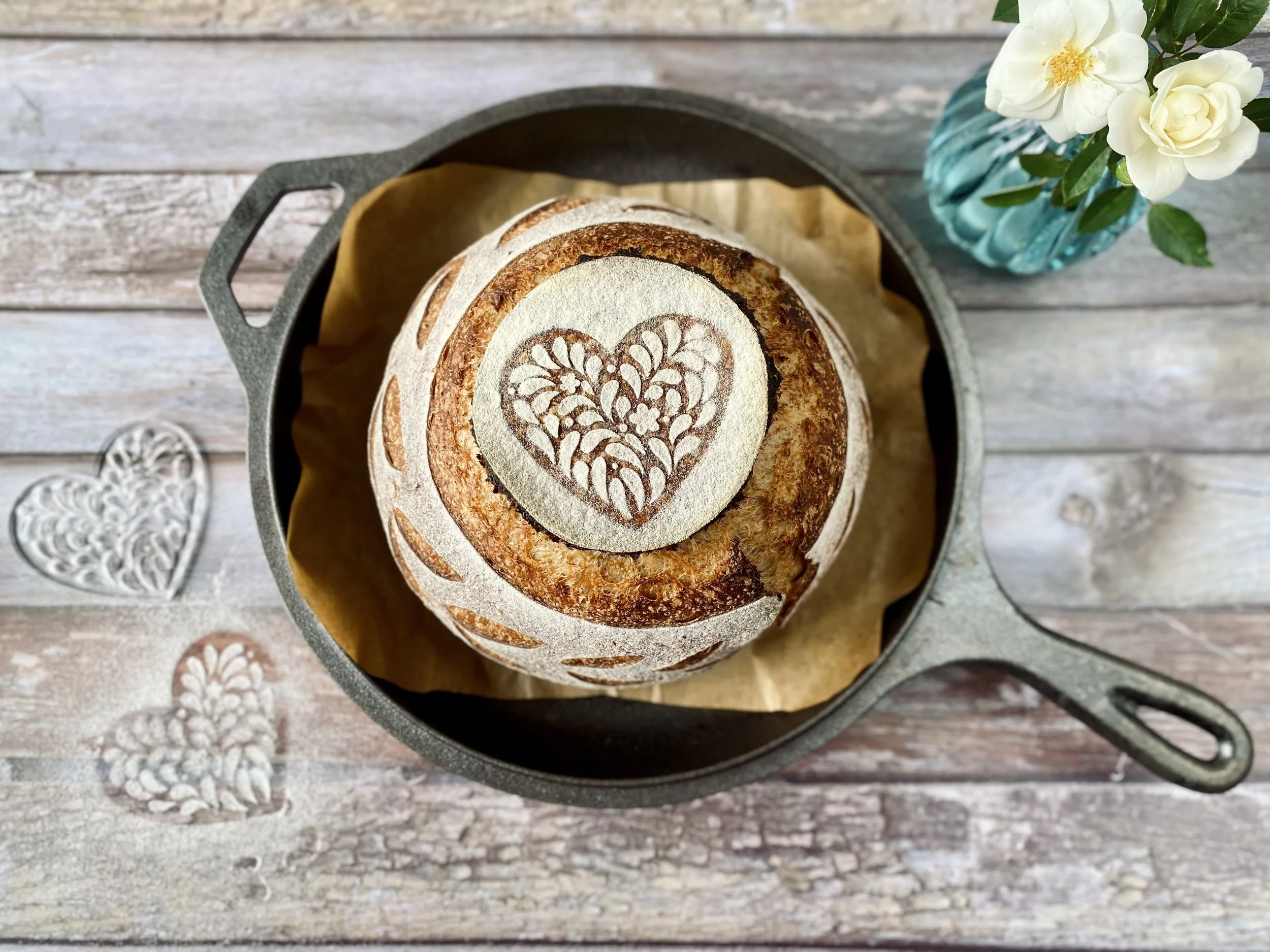Sourdough Bread 011
This is a pretty standard 70% white, 30% whole wheat sourdough bread with 80% hydration. The twist comes from incorporating scalded malted rye grains. If you haven't tried this method before, it's a delightful way to add extra flavour and texture into your bread.
A crucial tip is to add as little water as possible during scalding—just enough to soak the grains. And don’t drain the water after scalding, as you’ll be removing some of the goodness! Ensure the grains are fully incorporated into the dough; kneading can take a good few minutes here.
For decoration, I opted for a stencil this time. I have a handful of those with different patterns, perfect for making the bread look pretty without the effort of using an elaborate scoring pattern. For this bread, I have also included the 7-minute score.
Video with the process can be found on our YouTube channel.
Ingredients
Yields 2 loaves
140g active starter/levain
490g white bread flour
210g whole wheat flour
550g water (+10g)
15g salt
35g Shipton Mill Malted rye grains
60g hot water
Steps
STEP 1 | Autolyse
In a large bowl, combine the flour with 550g water and knead until there is no dry flour left. Cover the bowl and let the dough rest at room temperature for 1 hour.
STEP 2 | Scald rye grains
Place the grains in a small bowl, boil some water, wait to cool down a little and then pour 60g over the grains. Place aside.
STEP 3 | Add starter/levain
Add 140g active starter/levain to the flour/water mix and knead until fully incorporated. Cover the bowl and rest for 30 min.
STEP 4 | Add salt
Add 15g salt and 10g water and knead for a few minutes until the dough is smooth and supple. Cover the bowl and let the dough rest for 30 min.
STEP 5 | Add scalded rye grains
Add the scalded grains and knead for a few minutes until they are fully incorporated into the dough. Cover the bowl and let the dough rest for 30 min.
STEP 6 | Bulk fermentation
Perform one stretch and fold, rest the dough for 30 min, then perform four sets of coil folds, each 30 min apart.
Once you complete the last coil fold, cover the bowl and wait until the dough increases in volume by about 80-90%.
STEP 7 | Pre-shape
Transfer the dough onto a work surface, cut it in half with a bench scraper and pre-shape each part into a round. Cover with a towel and let the dough rest for 30 min.
STEP 8 | Shape & cold proof
After the 30-minute bench rest, shape the dough and transfer to the proofing baskets. Cover with a towel and let the dough rest for about 12 hours in the fridge.
STEP 9 | Score & bake
The next morning, score the dough, transfer to your baking dish, cover with the lid and place in the oven.
Bake for 25 minutes* at 250°C/480°F, then remove the lid and bake for an additional 15 minutes at 230°C/450°F.
* For the 7min expansion score—remove the dough from the oven after the first 7 minutes of baking, perform the additional score, cover with the lid and place it back into the oven. Bake for the remaining 18 minutes with the lid on. Then remove the lid and continue baking for the final 15min at 230°C/450°F.
Once baked, repeat with the second loaf.
Happy baking!
If you require more detailed recipe instructions, refer to our Beginner’s Sourdough Recipe.
And if you haven’t baked sourdough bread before, or need more guidance, check our New To Sourdough Baking section, where you can find details such as how to make your starter from scratch or the tools required to bake your first loaf of bread (including some of the tools we personally recommend).
What’s Next?
Transform your sourdough bread with our unique stencils. They are easy to use and will add a special touch to your loaves. Visit our store to see the full range.
We also highly recommend keeping a record of your process, timings, ingredients and techniques. Our Sourdough Fever Record Keeping PDFs will help you do all that and more. This 4-page PDF includes a record-keeping page, a basic sourdough recipe with instructions, and troubleshooting notes. You can download and print it at home. Click the photo below to find out more!



